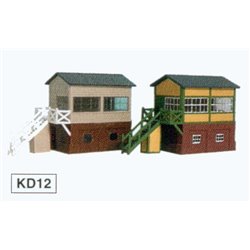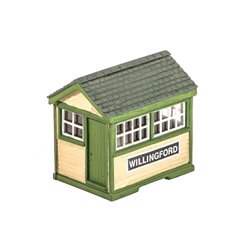Static grass puffer bottles work by manually charging model grass fibres with static electricity. When the charged...
No products
Product successfully added to your shopping cart
There are 0 items in your cart. There is 1 item in your cart.
Search Tips
What is a signal box?
A signal box, also known as a signal cabin or signalling box, is a critical component of the railway infrastructure in the United Kingdom. It is a building from which railway signals and points (also called switches or turnouts) are operated. The primary function of a signal box is to control the movement of trains, ensuring that they run safely and efficiently on the railway network. Signal boxes are strategically located along railway lines, typically at junctions, level crossings and other key points where train movements need to be closely monitored and managed.
Historically, signal boxes were operated manually by signalmen, who used levers to control the signals and points. These levers were connected mechanically to the railway infrastructure via an intricate system of rods and wires. The signalman would receive information about the location of trains from various sources, such as telegraphs or block instruments, and would then set the signals and points accordingly. This system allowed for safe coordination of train movements, preventing collisions and ensuring that trains followed the correct routes.
Over time, the design and technology of signal boxes evolved. Early signal boxes were often simple wooden structures, but as the railway network expanded and the demands on the signalling system increased, more robust and sophisticated designs were introduced. Some signal boxes were built in brick or stone, and many were raised on stilts to provide the signalman with a clear view of the tracks. The interior of a traditional signal box was typically dominated by a large lever frame, with each lever controlling a specific signal or point on the railway.
With the advent of modern technology, the role of traditional signal boxes has diminished. Many of the functions that were once performed manually by signalmen are now carried out by computerised signalling systems, which can manage vast sections of the railway network from a single control centre. These modern systems use electronic signals and track circuits to monitor train movements and automatically control signals and points. As a result, many of the old signal boxes have been decommissioned and either demolished or preserved as heritage sites.
Despite these changes, signal boxes remain an iconic symbol of the railway industry in the UK. Many enthusiasts and preservation groups have worked to restore and maintain historic signal boxes, recognising their importance as part of the country's industrial heritage. Some preserved signal boxes are open to the public as museums, offering a glimpse into the workings of the railway in a bygone era.
The transition from traditional signal boxes to modern control centres has brought significant improvements in efficiency and safety. However, it also marks the end of an era in which the role of the signalman was central to the operation of the railway. The skills and knowledge required to operate a manual signal box were considerable, and the job often demanded quick thinking and a deep understanding of the railway network. The decline of these roles reflects broader changes in the industry, as technology continues to reshape the way railways are managed and operated.
In conclusion, while the traditional signal box may be gradually disappearing from the British railway landscape, its legacy endures. Signal boxes played a crucial role in the development of the railway system, and their history is a testament to the ingenuity and dedication of those who worked within them. Whether preserved as historical sites or remembered through photographs and stories, signal boxes will always be an integral part of the UK's rich railway heritage.
Click here to receive the tips weekly in your mailbox. You can unsubscribe at any time.










